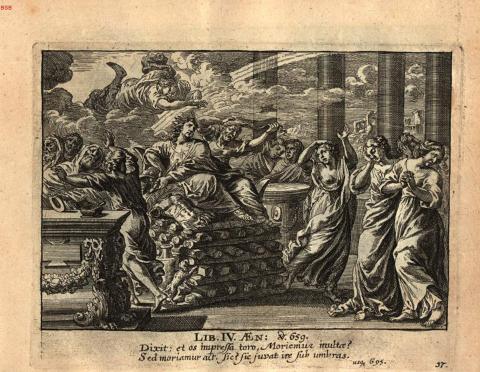Annotations
Dido stabs herself on the funeral pyre and Iris flies to cut off a lock of her hair; around the pyre are lamenting women.
Dido ersticht sich auf dem Scheiterhaufen, Iris fliegt herbei, um ihr eine Locke abzuschneiden; ringsum klagende Frauen. (Suerbaum)
Engraving from a German children’s picture-book version of the Aeneid by G. J. Lang and G. C. Eimmart, “A tapestry of Roman virtues as seen in Vergil’s Aeneas and his brave deeds, rendered in sparkling engravings, as illustrations of the remarkable deeds of antiquity, for the common benefit of noble youth,” (Peplus virtutum Romanarum in Aenea Virgiliano eiusque rebus fortiter gestis, ad maiorem antiquitatis et rerum lucem, communi iuventutis sacratae bono, aere renitens) (Nuremburg: J.L. Buggel, 1688), pl. 17.


This engraving centers on Dido’s suicide, the planning and execution of which take up the better part of Book IV. She sits on the pyre built at line 504, which appears exactly as she describes it from 494 through 497. It is open to the breezes (tu secreta pyram tecto interior sub auras erige 494-5) and Aeneas’ abandoned armor (helmet, shield, and breastplate) lies beside her. All the Carthaginians in the picture are lamenting, and Anna is behind her sister, rending her hair in grief. Dido herself appears calm, as she stabs herself. Above her is Iris, leaning on her rainbow as she cuts a lock of Dido’s hair, thus allowing her to die (704). In the distant background on the right appear ruins- perhaps Carthage, the building project stalled since the arrival of Aeneas (86-89). (Lucy McInerney)